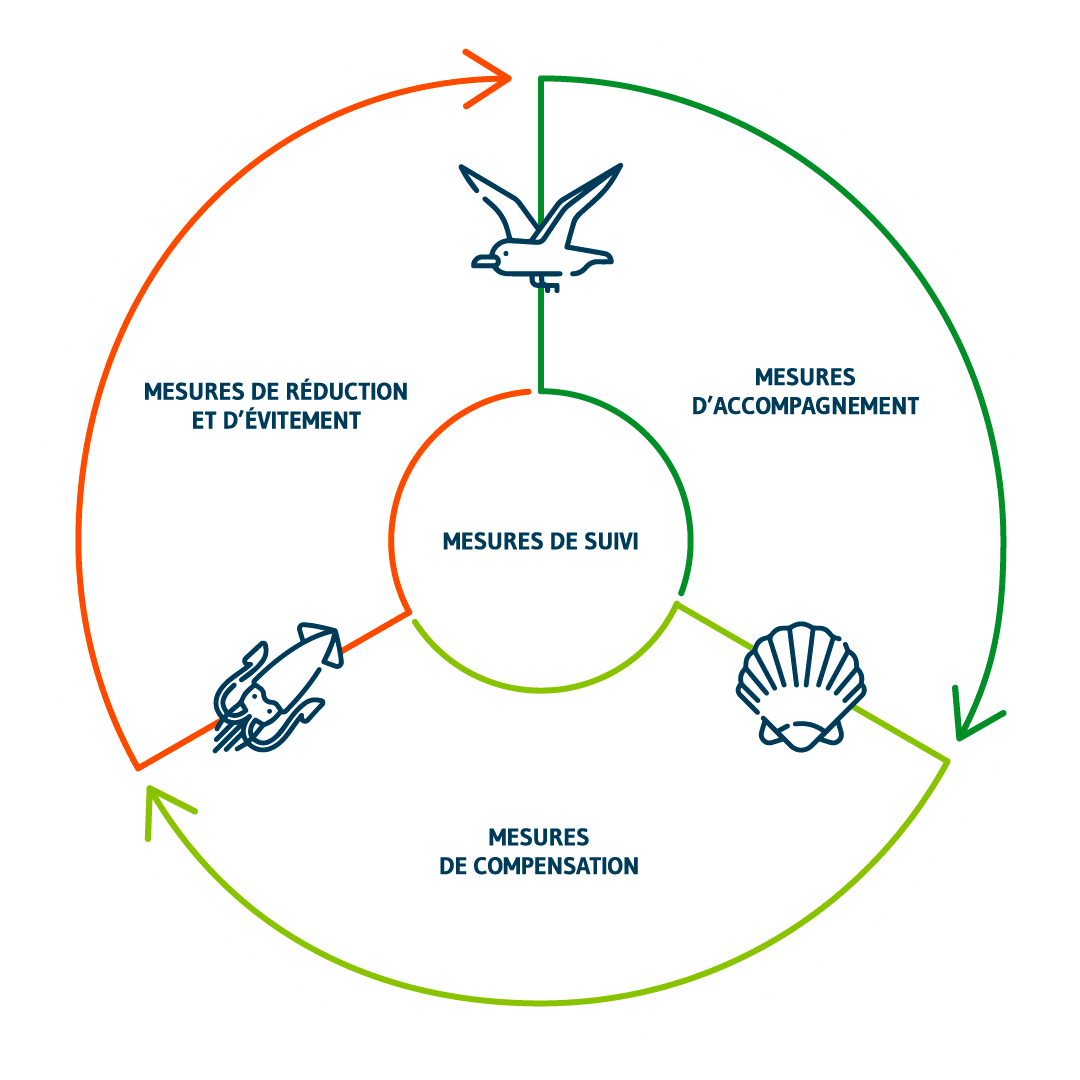The wind farm and the marine environment
Around thirty measures put in place

Follow-up actions
- Monitoring of nesting colonies
- Monitoring of marine mammals and birds by boat and plane (high-definition cameras)
- Acoustic monitoring of marine mammals using acoustic stations made up of hydrophones
Monitoring of birds by terrestrial radar at Cap Fréhel
- Monitoring of fisheries resources (fish, bivalves, cuttlefish, etc.)
- Monitoring of benthic biocenoses and sediment quality
- Modeling of turbidity during the works phase
...
Accompanying measures
- R&D program for the assessment of the impacts of underwater noise generated during works on fisheries resources
- Modeling of turbidity during the works phase
- Lookout points and information panels
- Definition and implementation of a tourist offer in link with local stakeholders
Reduction and avoidance measures
- Reduction of the disturbance of the Balearic shearwater during periods of internuptial presence
- Reduction of photoattraction during construction
Compensation measures
- Regulation of predation of bird eggs on Tomé Island by the American mink
- Regulation of egg predation on Cap Fréhel
- Awareness zone for marine mammals

Follow-up actions
Accompanying measures
Reduction and avoidance measures
Compensation measures
The “avoid, reduce, compensate” (ERC) sequence aims to avoid environmental damage, to reduce those which could not be sufficiently avoided and, if possible, to compensate for notable effects which have not been could neither be avoided nor sufficiently reduced. It applies to projects and plans and programs subject to environmental assessment as well as to projects subject to various procedures under the environmental code (environmental authorization, exemption from species protection, Natura 2000 impact assessment, etc. .).
All impacts are assessed using a monitoring program which focuses on all compartments (physical, chemical, biological, use). In addition, certain support measures are implemented to improve local knowledge.
Environmental studies carried out as part of the project
The impact study and the initial state
In 2015, an initial state of the marine environment was carried out as part of the impact study. This initial state is based on observations carried out from 2012 to 2015. The environmental studies carried out for the initial state concerned the physical (current, tide, geology, water quality, etc.) and living environments (marine fauna and flora, birds and bats, etc.), but also natural and heritage environments, the landscape and socio-economic aspects.
AU-IOTA Single Authorization
On April 18, 2017, the wind farm off the coast of Saint-Brieuc Bay, supported by Ailes Marines , obtained the administrative authorization known as “Single IOTA Authorization”. This authorization issued by the Prefecture of Côtes-d'Armor, under the provisions of articles L.214-1 et seq. of the Environmental Code, prescribes several monitoring, reduction, compensation or support measures.
Actions monitored locally
The actions carried out by Ailes Marines as part of environmental measures are monitored and evaluated by a Management and Monitoring Committee. This committee was created specifically for the wind farm by prefectural decree of 10/30/2017, and chaired by the prefect of Côtes d'Armor. It is mainly made up of representatives of the State, local authorities, Natura 2000 sites, professional fishermen, nature reserves. The latter can rely as much as necessary on the expert opinions of the Scientific Council created for the park.
Diversified environmental measures
With a view to limiting and monitoring the impacts of the construction and operation of the park on the environment, Ailes Marines is implementing numerous monitoring, reduction and compensation measures.
Environmental management system
The project is governed by an Environmental Management System (EMS) adapted to the specificities of offshore wind activity and the environmental sensitivities of the Bay of Saint-Brieuc. The EMS of the Saint-Brieuc project was certified ISO 14001:2015 in 2022.
The proper functioning of this system ensures the prevention of risks of environmental impacts during all phases of the project, as well as the continuous improvement of its environmental performance. .
Research and development
Participation of recognized experts
Ailes Marines has surrounded itself with numerous experts in order to carry out quality monitoring.
Two research programs on the impact of noise were launched in 2018/2019 on scallops, clams and cuttlefish. They are led by Laurent Chauvaud from the CNRS and Michel André from the University of Barcelona . These programs, at the cutting edge of research, will provide a better understanding of the impacts of noise in the context of the Saint-Brieuc project.
A world first, they will be useful for the entire profession and for the Marine Renewable Energy sector.
Research support
Ailes Marines wanted to support research for the marine environment by getting involved with local stakeholders.
For example, the RESIBAD aimed to develop expertise and operational tools for the characterization and validation of underwater noise reduction devices.
This project thus made it possible to improve the understanding of the effects of bubble curtains on the propagation of sound waves.
Want to know more ?
Browse our booklets
